
| Animals & Vegetarianism | |
| by T.J. Newton |
 |
|
| [UPDATED:
Part I of this post has been edited from the original 2009 version.] [UPDATED: Part III of this post was updated on Mar. 12, 2014] Part I So I want to talk about animals. Topics range from relationships with animals, such as keeping animals as pets, to eating animals and using animals in scientific research. But I want to start by saying that although I eat fast food hamburgers several times a week, as well as other fast food, I have thought about becoming a vegetarian. Still, I could tell you about my favorite fast food restaurants... That said, let's start with goats. The film The Men Who Stare at Goats came out in 2009. And I think goats have human-looking faces. Plus, people keep goats as pets. They can even be potty trained, but they have trouble holding their poops because they have 4-chamber stomachs, similar to cows. Still, they make great outdoor pets, and they're great with kids. |
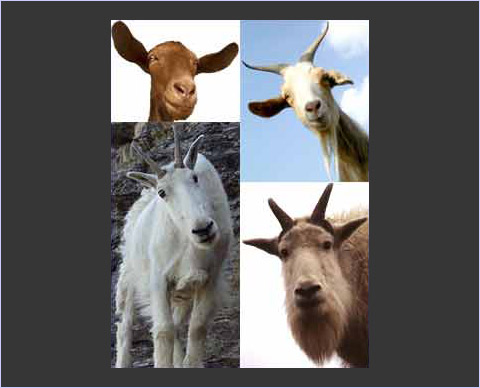
|
| Goats |
If you rule out eating goats, you'll also have to rule out eating pigs. Pigs are smarter than dogs, and they're kept as house pets. Of course, most people (myself included) enjoy pork, but there are some issues starting to surface... According to Kurt Cobain of the band Nirvana, "it's okay to eat fish, 'cause they don't have any feelings..." If I were to stop eating meat, I would still want to eat fish and seafood, because they don't seem at all like goats or pigs. I'd also eat eggs and dairy. Poultry could also be an option for me, but new research suggests it may not be. Fish and seafood can still be problematic, though, depending on various factors. For example, overfishing of pollock hurts sea lions. Catfish can be grown on farms, but they farm pigs, too. Cows and pigs, in particular, are treated very badly on many farms, and if you ever saw how they were treated, you would probably only want "organic" or "free range" meat (the term "free range" has no official definition). That's the kind of meat high-end restaurants serve to U.S. Senators. Cow, pig, and chicken "farms" are also famous for diseases like swine flu, bird flu, and E. coli, as well as various infections. Things have gotten so bad that in the U.S., they now have to use pesticides on most of the animals and inject or spray them with antibiotics. But both people and animals are still getting sick. (They're injecting people now, too...) They also inject or feed many of the animals hormones and steroids to produce more meat, but the meat doesn't taste as good and can also make people sick. (Not to mention how bad it is for the animals...) Speaking of injections, a certain percentage of U.S. dairy cows that produce milk are injected with or fed hormones that make the cows produce extreme amounts of milk. They also inject or spray these cows with antibiotics because of problems associated with the hormones, as well as for other reasons. These practices harm the cows and cause problems with the milk. The thing is, there was never a shortage of milk in the U.S. A number of dairy cows started receiving BGH around the same time as the "got milk" ad campaign began. After discovering the problems, a number of Americans who cared about the human relationship with cows stopped drinking milk, identifying themselves as vegetarians or vegans. A Fox News affiliate in Tampa, Florida attempted to keep information about the problems quiet, ultimately firing two reporters. Japan, Canada, Australia, New Zealand and most of Europe banned the practice. Humans have had a special relationship with dairy cows for a long time. I think it would be a shame to end that relationship, although there are still problems that remain. If you've ever milked a friendly cow on a small farm or are just a fan of dairy, organic milk is now available from farms that treat cows humanely and don't inject or spray them with anything. (The organic milk tastes a lot better, too.) |
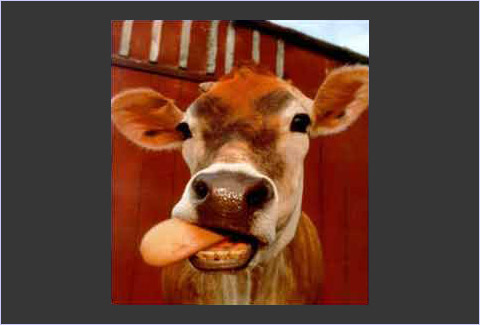
|
| A cow |
Did you know that milk and orange juice can be stored on an unrefrigerated store shelf for months or years, just like apple juice? It just has to be packaged differently (I can't remember whether it's an airtight, vacuum-packed, or airless container, though it does appear as though certain pasteurization technologies may also be involved). Americans buy it refrigerated because of the way grocery stores evolved. I don't know why I wanted to include that bit of info... Anyway, I've been thinking about animal issues for a long time, and one solution to many of the issues surrounding the eating of animals that I've supported has been "in vitro meat." That's where they "grow a steak" in a special facility without ever killing a cow. In 2013, they'd managed to grow an entire hamburger. It was cooked by a master chef and tasted by some food critics, and while not that different from a regular burger, it contained no fat. PETA supports this idea, and more and more NewsKingers may be in favor of in vitro meat... I also support of the use of animals in scientific research. We wouldn't know anything about stem cells, for example, without animal testing. Of course, I certainly don't support unnecessary testing or inhumane treatment of animals used in testing... I don't support cloning animals for human consumption, though. It's "stupid science." It causes more problems than it solves. There is no economic, philosophical, or scientific reason for doing it. Some of the arguments being made remind me of debates about genetically engineered crops. It's like, economists, philosophers, and scientists are busy arguing about Agri-Darwin-Galileo, but the point that's getting lost is about nature. History has handed humanity some bad experiences. While we want to expand knowledge, we can't go forward with an axe to grind. Of course, corporate marketing may be responsible for injecting the debate with a lot of nonsense. I should probably do a new post about cloning and genetically modified organisms (by the way, I oppose genetically modifying crops, and oppose cloning or genetically modifying animals for human consumption), but fortunately agribusiness has resisted cloning or genetically modifying animals for human consumption. Let's move on. Everyone loves animals, so it's time to talk about some of the soy- and vegetable-based meat and dairy products available. In addition to burgers, there are chicken nuggets, tacos, and even lasagna made from soy and vegetables. There are so many products available, I can't even begin to list them all, but most grocery stores carry them now. There are also dairy-style products such as soy milk and cheese made without animal products. All of these foods are very delicious, and I think more people should try them! |
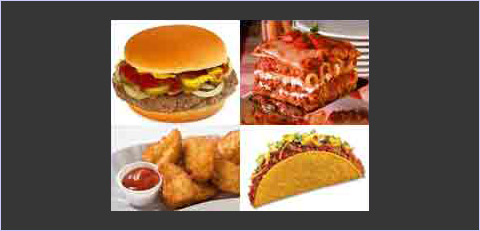
|
| Soy- and vegetable-based meats used in typical American food |
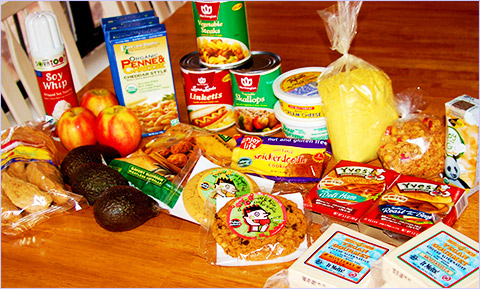
|
| An assortment of soy and veggie products available from grocery stores |
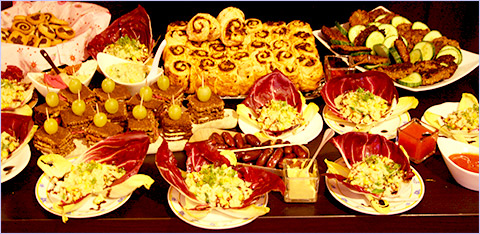
|
| A vegetarian buffet |
Still, most people continue eat meat because they like the taste and because it is widely available and inexpensive. America's appetite for meat has some of its roots in the Great Depression. Soldiers were showing up for duty with no meat on their bones, and school children looked even worse. In other words, America was literally starving to death when a lot of this started... During the late twentieth century, America was able to produce and distribute inexpensive hamburgers and, along with other foods in the American diet, they are often associated with the rise in obesity in America. In fact, roughly 1 in 3 Americans are now struggling with issues related to obesity. And industrialized meat production has turned into a post-war monster with its own problems... (With their 4-chamber stomachs, industrial cows emit gas in amounts so great that they are considered a huge contributor to global climate change, while cattle farms and hog farms leak raw animal sewage into human drinking water at least once per year.) In the 21st century, talking about animals and vegetarianism is more challenging than ever. Take Bill O'Reilly, for example. He went on Fox News television and shouted, "I'd rather die than not eat steak!" I wonder if he could be talked into "in vitro sirloin?" |
Part II A number of things have changed since I originally wrote Part I of this post back in 2009... Hardee's/Carl's Jr., Burger King, and a number of other fast food or burger restaurants have introduced turkey burgers. U.S. chicken can now be shipped to China for uninspected processing. Bacon - one time an expensive delicacy - has seen an increase in popularity. The dairy industry has tried to stop the use of the word "milk" in soy milk products. Bill Clinton has become a vegetarian. And understanding vegetarian diets has become something people are at least more curious about. Shortly after publishing Part I of this post in 2009, another development came to my attention in a 2010 article I read about conscious cognition in humans, other mammals, and birds. It seemed to be related to my original statement that, if I adopted a vegetarian diet, I would still consume fish, seafood, and poultry. I didn't go into much detail about why I made the statement, but I said that these food categories seemed different from beef or pork (I said "goats or pigs," but same idea). Well, I worded it that way because consciousness in humans - if you accept that humans are conscious - is thought to be related to the presence of a prefrontal cortex in the human brain. Humans are the only animals thought to be conscious, but humans are mammals, and all mammals have a prefrontal cortex. Mammals include humans, dogs, cats, goats, cows, pigs, rabbits, elephants, horses, lions, tigers, bears, etc... |
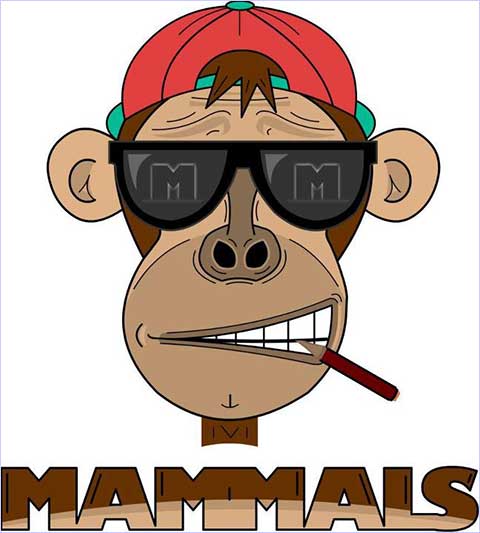
|
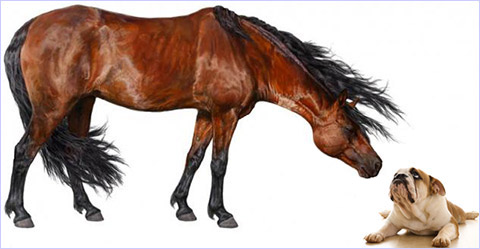
|

|
In 2013, I shared another article I read that included ideas about "defining consciousness" and "degrees of consciousness." The idea of human consciousness is now more accepted in the scientific community. When ideas about consciousness are combined with ideas about conscious cognition in humans, other mammals, and birds, it is a source of curiosity for vegetarians and non-vegetarians alike. While this has nothing to do with why some people adopt a vegetarian diet, and while I'm not going to suggest that eating animals is wrong, I think most people find it interesting. The most interesting part of the article about conscious cognition in humans, other mammals, and birds was that it spent a lot of time on birds and cognition (the article was called "Who You Callin' 'Bird Brain?'"). Birds are not mammals, and don't have a prefrontal cortex. But the article suggested that at least in some birds, other parts of the brain made up for the lack of a prefrontal cortex, and these birds appear able to pass the same tests given to mammals. Other studies have confirmed this idea. Little else is known at this point, but if this information weighs on your decision about whether or not to include poultry in your vegetarian diet, it may be interesting to you. |
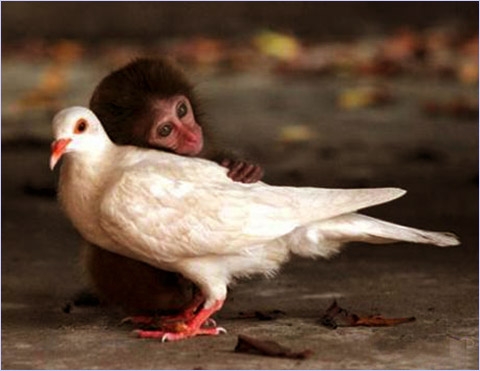
|
Some people just like fruits, vegetables, and other foods that easily fit with a vegetarian or semi-vegetarian diet. Sometimes these folks identify as vegetarians, and sometimes they don't. When asked about their favorite food, some people answer "corn," "tomatoes," "apples," etc. Many vegetarian or semi-vegetarian foods even have "fans." |
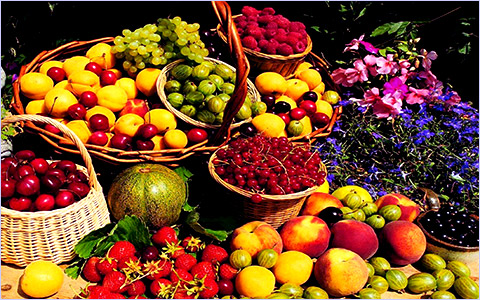
|
| Fresh fruit |
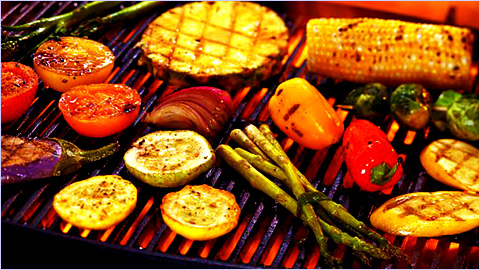
|
| Grilled vegetables |
Part III Part III is about vegetarian diets and proper nutrition. There are different types of vegetarians, and vegetarian diets must be planned accordingly. The table below shows the different types of vegetarians along with the associated food categories for each type. After reviewing the table, review the information below it to help plan a vegetarian diet that suits your needs to ensure you get adequate nutrition. The dietary information that follows the table was compiled from the U.S. National Institutes of Health and the U.S. Department of Agriculture. |
A well-planned vegetarian diet can give you good nutrition. A vegetarian diet often helps you have better health. Eating a vegeterian diet can help you reduce your chance of obesity, reduce your risk of heart disease, lower your blood pressure, and lower your risk of type 2 diabetes. Compared to non-vegetarians, vegetarians usually eat fewer calories from fat (especially saturated fat), fewer overall calories, and more fiber, potassium, and vitamin C. |

|
Anyone following a vegetarian diet needs to make sure to get enough important nutrients. This is because it may be hard to get all the calories and nutrients needed for growth and development and to maintain good health. Careful planning may be needed for certain groups of people such as young children and teens, pregnant or breast-feeding women, older adults, and people with cancer, more severe lung problems, and other illnesses. Vegetarian diets are usually high in fiber. High-fiber diets may lack calories, which can lead to growth and development problems in infants and children, poor growth of a baby while still in a mother's womb, and weight-loss in those who are ill or older. If needed, take supplements if your diet lacks certain vitamins and minerals. Vegetarian diets often lack certain vitamins and nutrients. You may want to pay attention to the following: - Vitamin B12: Sources include eggs, milk products, and foods that have B12 added to them (fortified). - Vitamin D: This vitamin is found in fatty fish, egg yolks, and foods that are fortified with vitamin D, such as soymilk and cereals. - Zinc: Sources of this mineral include beans and foods fortified with zinc, such as milk and cereals. - Iron: This mineral is found in beans, green vegetables, and foods fortified with iron such as cereals. Eating foods that are high in vitamin C at the same meal as iron-rich foods increase iron absorption. Vitamin C helps the body absorb iron. |
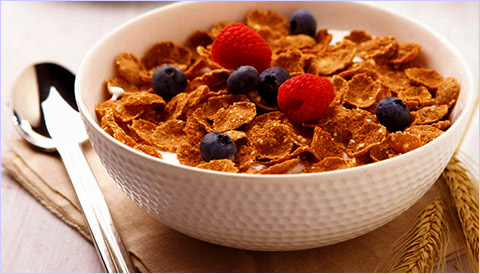
|
- Calcium: Sources of this mineral include milk, seeds, beans, nuts, green vegetables, and foods fortified with calcium such as fruit juices. Calcium-fortified soymilk provides calcium in amounts similar to milk. It is usually low in fat and does not contain cholesterol. - Protein: Sources of protein include fish, eggs, beans, soy products, nuts and nut butters. If you eat fish, eggs, and dairy, getting enough protein should be easy. Even if you do not, proteins from plants can still provide a healthy diet. Soy protein, such as soy nuts, tofu, veggie burgers, chicken substitute, and soy cheese are good sources of protein, along with legumes and beans, such as navy beans, split peas, and chickpeas. Nuts, peanut butter and other nut butters, and almond milk are also good protein sources; so are seeds and whole grains. Vegetarian diets that include some dairy products and eggs are nutritionally sound. |
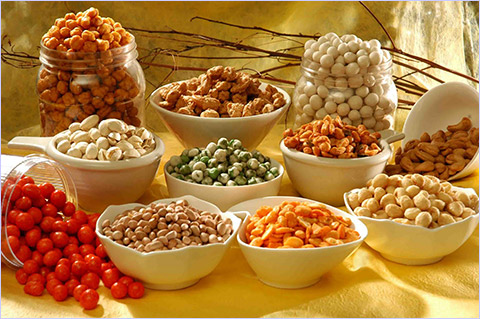
|
You may want to work with a dietitian to ensure that your nutrients are adequate. When following a vegetarian diet, be sure to eat different kinds of foods, including vegetables, fruits, beans, nuts, seeds, whole grains, and dairy and eggs if your diet includes these. Limit foods that are high in sugar, salt (sodium), and fat. Do not make up for a missing nutrient by overeating another. For example, do not eat a lot of high-fat cheese to replace meat. Instead, choose protein sources that are low in fat, such as beans. Learn to read the Nutrition Facts Label on food packages. The label tells you the nutrition contents of the foodproduct. |
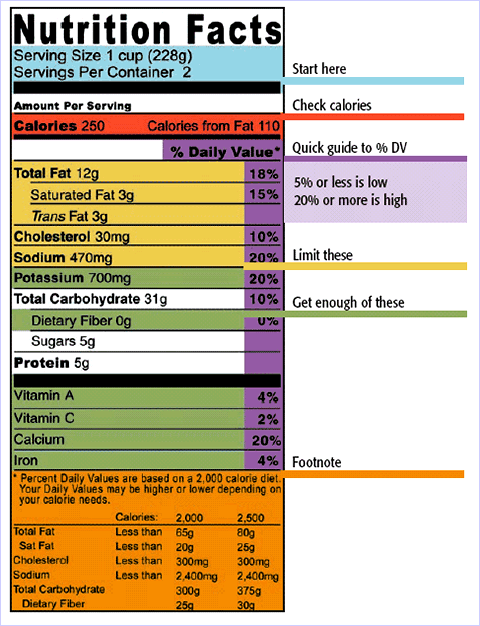
|
The Ingredient Label is usually located near the Nutrition Facts Label. Ingredients are required to be listed in order of greatest amount to least amount. Watch for hydrogenated, partially hydrogenated, interesterified, or fractionated oils; palm kernel oil; high fructose corn syrup (HFCS); and monosodium glutamate (MSG). Sometimes MSG is disguised as "hydrolyzed protein," such as "hydrolyzed corn protein," "hydrolyzed soy protein," etc. If you are a vegetarian, be aware that casein, whey, and gelatin are considered animal ingredients (casein and whey are dairy, gelatin can be made from mammal by-products). |
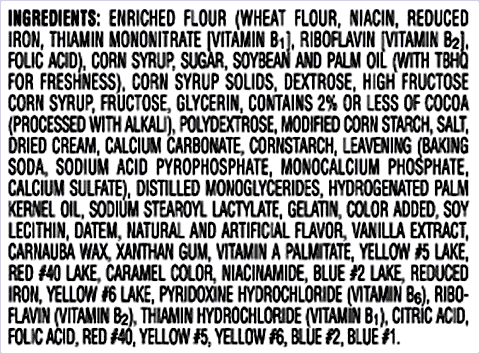
|
See Also: - Ex-Military Thugs Now Enforce Genetic Patents - Factory Farms Make People Sick Related - Part I: - http://en.wikipedia.org/wiki/Animal - http://en.wikipedia.org/wiki/Pet - http://en.wikipedia.org/wiki/Vegetarianism - http://en.wikipedia.org/wiki/Animal_testing - http://en.wikipedia.org/wiki/Fast_food - http://en.wikipedia.org/wiki/Goat - http://en.wikipedia.org/wiki/The_Men_Who_Stare_at_Goats_(film) - http://en.wikipedia.org/wiki/William_Windsor_(goat) - http://en.wikipedia.org/wiki/Pig - http://en.wikipedia.org/wiki/Nirvana_(band) - http://en.wikipedia.org/wiki/Fish - http://en.wikipedia.org/wiki/Seafood - http://en.wikipedia.org/wiki/Poultry - http://en.wikipedia.org/wiki/Semi-vegetarian - http://en.wikipedia.org/wiki/Sea_lions - http://en.wikipedia.org/wiki/Catfish - http://en.wikipedia.org/wiki/Intensive_pig_farming - http://en.wikipedia.org/wiki/Cow - http://en.wikipedia.org/wiki/Factory_farming - http://en.wikipedia.org/wiki/Free_range - http://en.wikipedia.org/wiki/Swine_flu - http://en.wikipedia.org/wiki/H5N1 - http://en.wikipedia.org/wiki/E._coli - http://en.wikipedia.org/wiki/Infection - http://en.wikipedia.org/wiki/Pesticide - http://en.wikipedia.org/wiki/Antibiotic - http://en.wikipedia.org/wiki/Hormones - http://en.wikipedia.org/wiki/Steroid - http://en.wikipedia.org/wiki/Milk - http://en.wikipedia.org/wiki/Bovine_somatotropin - http://en.wikipedia.org/wiki/Got_milk - http://en.wikipedia.org/wiki/Veganism - http://en.wikipedia.org/wiki/Organic_milk - http://en.wikipedia.org/wiki/In_vitro_meat - http://en.wikipedia.org/wiki/PETA - http://en.wikipedia.org/wiki/Cloning - http://en.wikipedia.org/wiki/Genetically_modified_food - http://en.wikipedia.org/wiki/Meat_analogue - http://en.wikipedia.org/wiki/Soy - http://en.wikipedia.org/wiki/Vegetables - http://en.wikipedia.org/wiki/Soy_milk - http://en.wikipedia.org/wiki/Cheese_analogue - http://en.wikipedia.org/wiki/Great_Depression - http://en.wikipedia.org/wiki/Western_pattern_diet - http://en.wikipedia.org/wiki/Obesity_in_the_United_States - http://en.wikipedia.org/wiki/Flatulence#Environmental_impact Artwork (may include photos, images, audio, and/or video) - Part I: - Artwork carried over from the original 2009 post was not sourced. - http://limabeanlover.files.wordpress.com/2010/03/garden-cove... - http://strullersuppe.files.wordpress.com/2012/10/img_8579.jpg Related - Part II: - http://discovermagazine.com/2010/mar/01-who-you-callin-bird-brain - http://www.smithsonianmag.com/science-nature/lisa-randalls-guide... - http://en.wikipedia.org/wiki/Prefrontal_cortex - http://en.wikipedia.org/wiki/Neocortex - http://www.ncbi.nlm.nih.gov/pubmed/16263260 - http://en.wikipedia.org/wiki/Consciousness Artwork (may include photos, images, audio, and/or video) - Part II: - http://funkadelphia.files.wordpress.com/2012/09/mammals2.jpg - http://s.imwx.com/dru/2013/11/0383726a-968e-4ebc-835f... - http://nodogaboutit.files.wordpress.com/2012/06/j0435910.jpg - http://images.wisegeek.com/dog-and-cat-staring-at-eachother.jpg - http://insectforum.no-ip.org/gods/non-cgi/usravatars... - http://www.marinecatering.com/wp-content/uploads/2013/07/fruit... - http://a.abcnews.com/images/Health/gty_grilled_vegetables... Related - Part III: - http://www.nlm.nih.gov/medlineplus/ency/article/002465.htm - http://www.choosemyplate.gov/healthy-eating-tips/tips... - http://www.choosemyplate.gov/food-groups/downloads... - http://en.wikipedia.org/wiki/Semi-vegetarianism Artwork (may include photos, images, audio, and/or video) - Part III: - http://www.chinesemedicineliving.com/blog/wp-content... - http://i.cdn.turner.com/cnn/2011/HEALTH/03/22/cereal... - http://stat.ks.kidsklik.com/statics/files/2013/11... - http://www.health.gov/dietaryguidelines/dga2005/toolkit... - http://www.attunefoods.com/blog/wp-content/uploads... |
 |
| © 2015
by T.J. Newton. All Rights Reserved. A more detailed copyright policy should be forthcoming. It will probably be similar to this one. |
 |